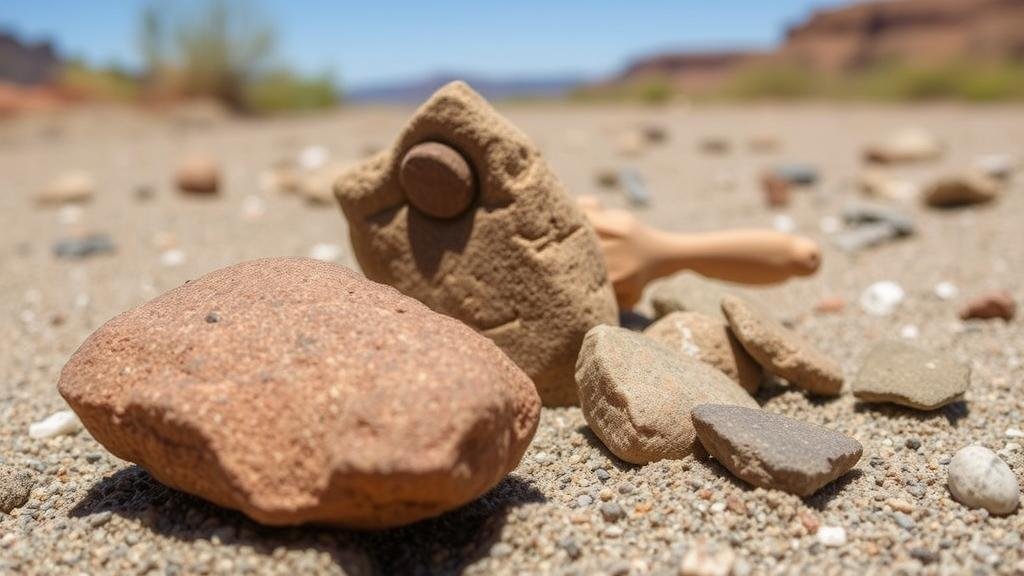Recovering Stone Artifacts in Sandy River Washes and Deserts
Recovering Stone Artifacts in Sandy River Washes and Deserts
Recovering stone artifacts from sandy river washes and desert environments is a crucial aspect of archaeological research. This process allows researchers to gain insights into past human behaviors, cultures, and interactions with their environments. In this article, we will explore the methods used for artifact recovery, the significance of these artifacts, and the challenges faced in such arid and dynamic landscapes.
Understanding the Environment
The sandy river washes and desert terrains present unique challenges and opportunities for archaeologists. e environments are characterized by their shifting sands, extreme temperatures, and limited vegetation.
- Shifting Sands: The movement of sand can expose buried artifacts as well as bury them again, making recovery unpredictable.
- Climate Conditions: Deserts experience significant daily temperature fluctuations, affecting both the preservation of materials and the comfort of researchers conducting fieldwork.
Desert archaeological sites are often associated with ancient human activities such as hunting, gathering, and tool-making. Understanding these settings is pivotal for effective excavation and artifact recovery.
Techniques for Artifact Recovery
The recovery of stone artifacts requires a combination of careful planning, methodical excavation, and analytical techniques. Here we elaborate on some of the most effective methods:
1. Surface Survey
Conducting surface surveys is a preliminary step that involves scanning the landscape for visible artifacts. Archaeologists often employ GPS technology and mapping software to document the location and context of each find. For example, studies conducted along the Colorado River have utilized this technique to identify patterns of human settlement and resource use historically.
2. Stratigraphic Excavation
Stratigraphic excavation involves digging in layers to understand the chronological context of artifact deposits. By carefully removing soil in a controlled manner, archaeologists can establish a timeline of human occupation. This method was notably used at the Cactus Flat site in Nevada, where researchers discovered artifacts dating back over 9,000 years.
3. Site Stabilization Techniques
In environments prone to erosion or disturbance, site stabilization becomes essential. Techniques such as fencing around sensitive areas and using sandbags can protect fragile sites during excavation and recovery. The Granite Washes in Arizona have seen successful applications of these techniques, preserving valuable archaeological data.
Significance of Stone Artifacts
Stone artifacts provide extensive information about the technological and cultural practices of past communities. analysis of these artifacts assists in understanding various aspects of ancient societies, including:
- Tool Technology: Studying the manufacturing methods of stone tools informs researchers about the technological capabilities of prehistoric peoples.
- Trade Networks: The materials used in artifacts can reveal trade patterns and resource acquisition strategies. For example, the presence of obsidian tools indicates long-distance trade routes used by ancient peoples.
In essence, these artifacts serve as time capsules, containing vital information about human adaptation and resilience in challenging environments.
Challenges in Recovery
Recovering stone artifacts in sandy river washes and deserts is not without its challenges. Some of the most pressing include:
- Environmental Factors: High winds and storms can rapidly alter landscapes, leading to the loss of potential sites or artifacts.
- Legal and Ethical Concerns: Issues surrounding land ownership and the preservation of cultural heritage complicate archaeological work.
- Resource Limitations: Funding and manpower constraints often limit the extent and duration of archaeological projects.
These realities necessitate adaptive strategies and collaborative efforts among researchers, local communities, and regulatory bodies to ensure effective artifact recovery and preservation.
Case Studies
Numerous archaeological projects illustrate successful strategies for artifact recovery in desert and river environments. following are notable examples:
1. The Lower Pecos Canyonlands
In Texas, the Lower Pecos Canyonlands have yielded significant stone tools dating back thousands of years. Researchers found extensive evidence of human habitation, supported by careful stratigraphic excavation. Artifacts recovered from this region have contributed to a deeper understanding of hunter-gatherer societies in arid contexts.
2. The Mojave National Preserve
The Mojave National Preserve in California has been a focal point for archaeological surveys. Evidence of ancient trade routes has been uncovered, along with a variety of stone artifacts demonstrating the adaptability of indigenous populations to the harsh desert environment.
Conclusion
Recovering stone artifacts in sandy river washes and deserts is a dynamic field of study that necessitates a multifaceted approach to excavation and analysis. By understanding the environmental challenges and employing effective recovery techniques, researchers can continue to uncover valuable insights into our human past. As we move forward, it is essential to prioritize collaboration, ethical practices, and the sustainable management of archaeological sites to protect our cultural heritage for future generations.
Actionable Takeaways
- Engage in rigorous field surveys and recoveries to document the archaeological record accurately.
- Use stratigraphic excavation techniques to provide historical context to recovered artifacts.
- Collaborate with local communities and stakeholders to address legal and ethical considerations in archaeological work.



